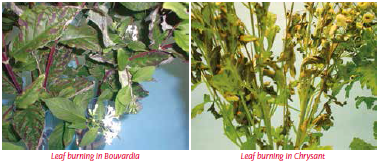- Purchase plants of sufficient maturity and quality
- Pay attention to the activity of the plants e.g.
The composition of cut flower food is like a balanced diet for cut flowers. The universal products are a general diet for all cut flowers and the speciality flower foods are a diet that is fine-tuned according to the needs of a particular flower type. Cut flower research has shown that even within a flower type there can be variations. In practice, though, speciality flower foods are not always available. The ultimate goal is to provide cut flowers with the food and water as if still intact to the mother plant. Over- or underdosing with flower food will cause a less than optimum result.
This well-known phenomenon is the premature wilting of the flowers that are sensitive to vascular blockages, such as Rosa, Bouvardia, Chrysanthemum and Gerbera.
Plant development and its duration, in connection with climatic conditions and other factors, are different for each plant type and cultivar. Deviations from the optimum care will lead to a shorter shelf life for the consumer. Post-harvest treatments do not have the power to influence the genetic potential of the plant and are not formulated as such.
Flower development and its duration, in connection with climatic conditions and other factors, are different for each flower type and cultivar. Deviations from the optimum care will of course lead to a shorter vase life for the consumer.
 Premature harvesting is the core problem of bent-neck in roses. The stem right under the bud is not strong enough to carry the weight of the growing bud/flower. When the stem bends in this way, the vascular bundles are pinched shut and the flower’s water supply is cut off. The leaves, on the other hand, remain healthy.
Premature harvesting is the core problem of bent-neck in roses. The stem right under the bud is not strong enough to carry the weight of the growing bud/flower. When the stem bends in this way, the vascular bundles are pinched shut and the flower’s water supply is cut off. The leaves, on the other hand, remain healthy.
Botrytis cinerea (grey mould) is a fungus which causes a loss of quality in flowers like Rosa, Chrysanthemum, Gerbera and Lisianthus. The place of origin, season, hygiene during processing and storage, weather conditions and climate control play an important role in the appearance and development of Botrytis. The fungus thrives on both living and dead plant materials. The infection starts when miniscule little mould spores, spread through the air. Starting as a little white speck (‘pock’) on the flower petals, it spreads right to the bottom of the flower.
Stems carry the flower and give the flower access to water. The stem should remain undamaged to enjoy the flowers as long as possible. Do not remove bark or thorns from the stem. Did you know that stem scrapers and thorn removers belong to the top 10 list of torture treatments for flowers?
Effects of stem scraping
Scraping damages the stem bark, the flowers natural protection, causing a large stem wound. Result: a quickly wilting flower, a short vase life, extra waste for the florist/retailer and a disappointed customer.


